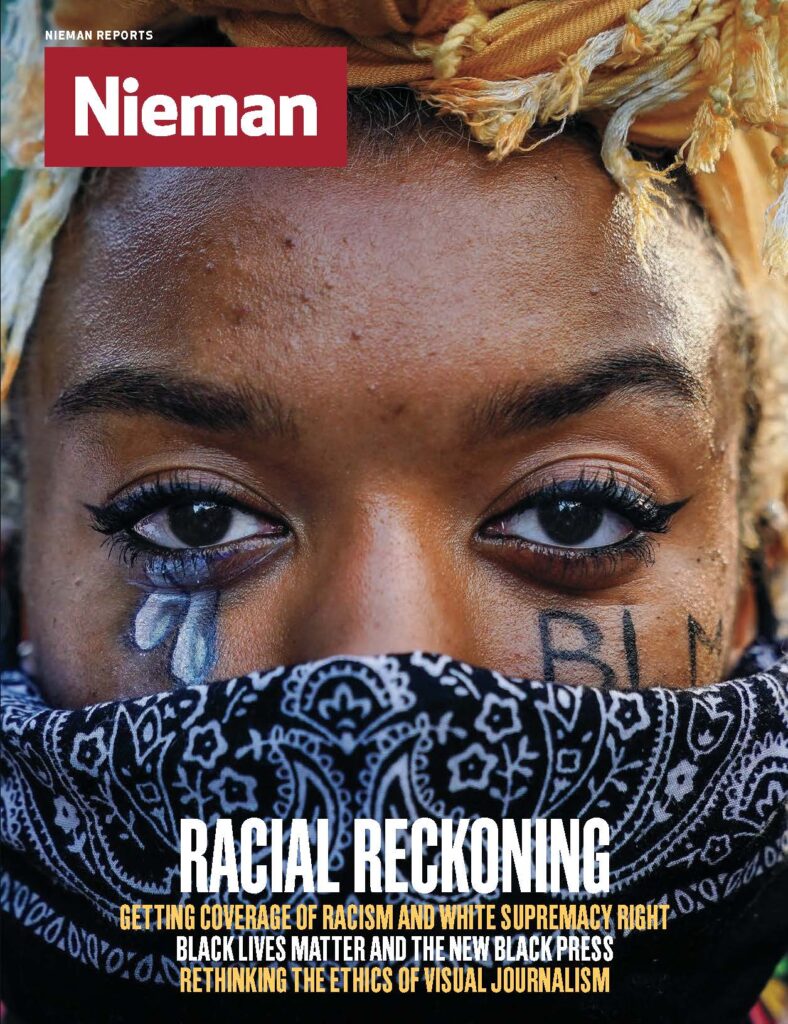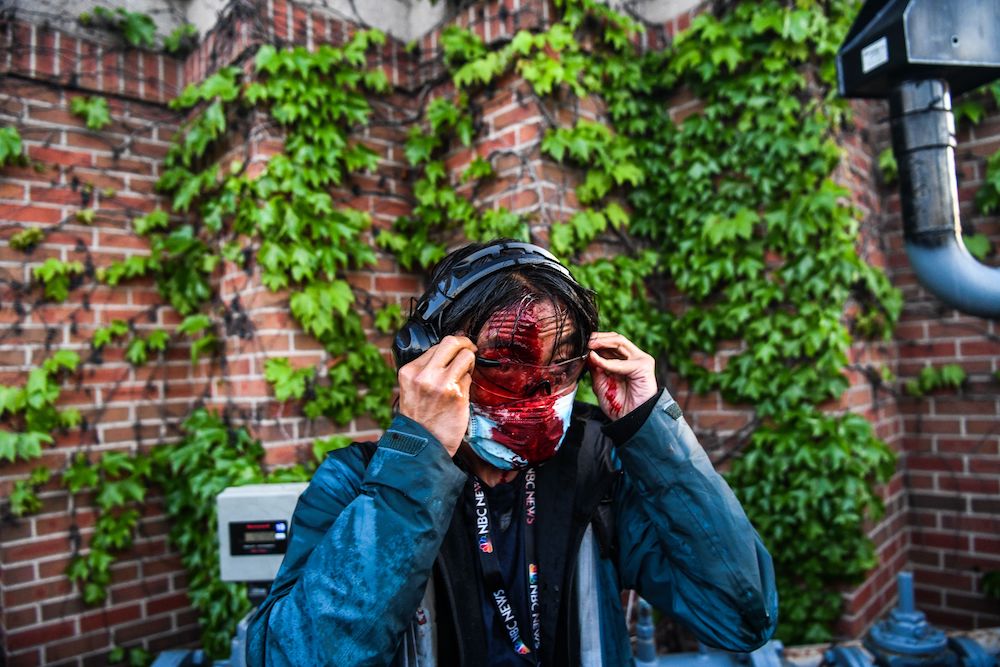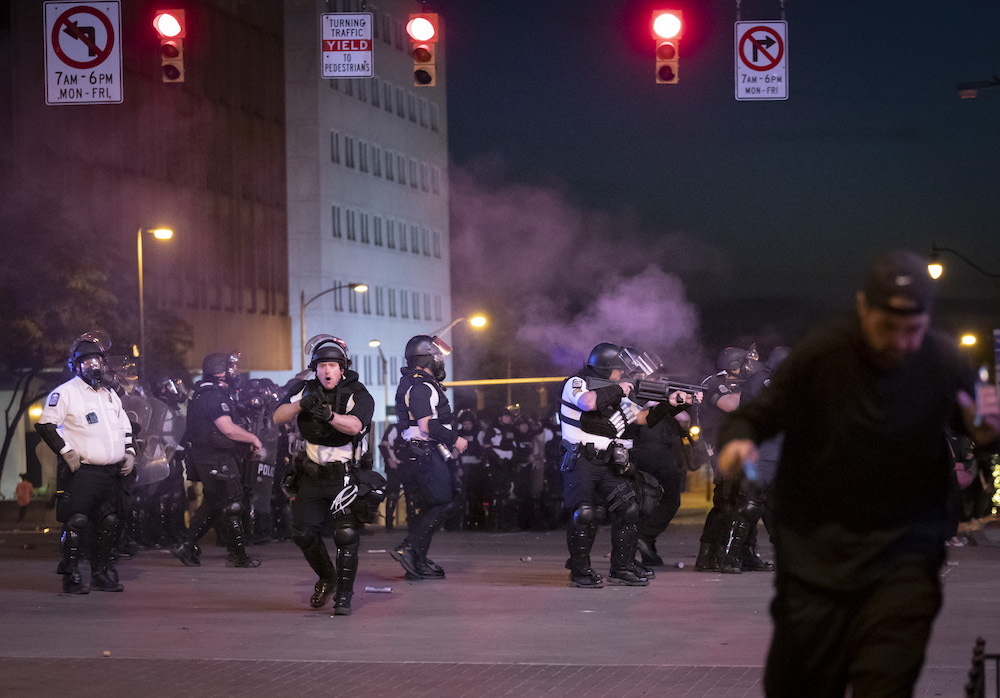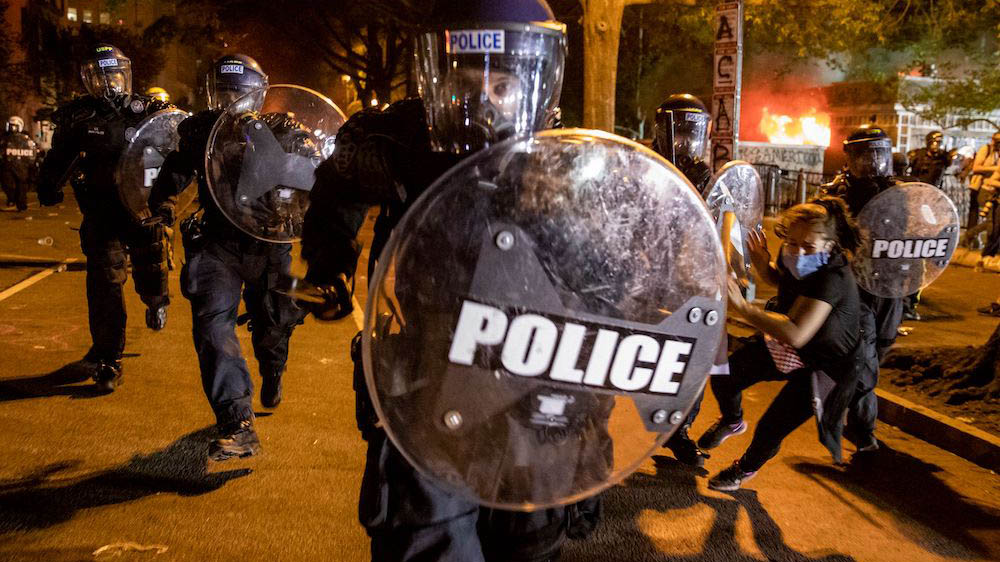
As the coronavirus pandemic wears on and the racial justice movement in the U.S. continues to amplify in the wake of George Floyd’s killing, American society — and American newsrooms — are faced with urgent challenges as well as opportunities for change.
How are news organizations covering this unprecedented time, and how are journalists managing the trauma and stress associated with that work? Nieman Reports examines how the reinvigorated movement for racial justice and the pandemic are prompting newsrooms to fundamentally rethink how stories are covered — and by whom.
Friends and colleagues began calling Sarah Glover soon after the world witnessed the killing of George Floyd on video. Black journalists were hurting, in need of empathy and solutions, trying to figure out how to navigate their personal feelings and their professional roles. “I woke up one morning and thought, ‘These people are in distress, how can I help?’” says Glover, an NBC social media strategy manager and a former president of the National Association of Black Journalists.
Within four days, she arranged and publicized a two-hour virtual wellness check-in, with the help of Kari Cobham, the senior associate director of The Rosalynn Carter Fellowships for Mental Health Journalism and Media. Forty-eight hours before the Sunday afternoon event, Glover posted an online flyer, expecting perhaps 10 people would be interested on such short notice. Instead, 107 people registered, and 45 participated for the entire session, also hosted by the Diverse Social Media Editors & Digital Journalists Facebook group. “It really speaks to the fact that there’s a need for everyone to process these events, both as individuals and as journalists,” Glover says.
Three mental health professionals — a psychiatrist, a clinical social worker, and a happiness scholar — offered self-care suggestions and positive messages about self-worth: be gentle with yourself, practice gratitude, value friendships. If the advice could be boiled down to one sentence, it would be this plea from Atlanta psychiatrist Sarah Y. Vinson: “Give yourself permission to be human.” Strategies could range from stepping away from a big story to recharge for a day to simply vowing to leave your cellphone and laptop in another room when you go to bed.
In an industry overwhelmed and understaffed, and vilified from both sides of the political divide, the journalistic ethos of heading enthusiastically to cover mayhem and danger has collided with burnout and trauma. The stigma of admitting a mental health challenge runs deep among people who view their work as a calling. They are known more for forgetting problems at the after-work bar than addressing them in the therapist’s office.
But a new generation of journalists may be looking for a change. A 2015 American University survey found that millennials report more mental health issues than previous generations, and also show a greater willingness to speak about their struggles. In addition, a confluence of traumatic events, including the pandemic, the financial collapse of the news industry amid an economic shutdown, and the cascade of police violence has contributed to a sense that mental health care is as necessary as physical health care.
Research on trauma in journalism came into its own about 20 years ago. It has traditionally focused on the post-traumatic stress of frontline reporters and photographers who have worked in global hot spots and war zones, and the psychological symptoms that develop after experiencing terror, fear, or overwhelming violence. But deeply disturbing events so close to home have expanded awareness and urgency about what constitutes a mental health challenge for journalists.
“We really have three interlocking mental health-inflected crises at once,” says Bruce Shapiro, executive director of Columbia University’s Dart Center for Journalism and Trauma, a resource center for journalists who report on and experience trauma.
Journalists dealing with the relentlessness of covering a global pandemic that may be affecting them personally are now faced with the added stress of covering protests in which reporters and photographers have been assaulted and arrested for doing their jobs. For Black journalists, these stressors are magnified by the precipitating event of the protests — a Black man, Floyd, dying on video at the hands of a white Minneapolis police officer now charged with murder.
The rate of anxiety and depression among African-Americans rose in the week after the Floyd murder, from 36% to 41%, according to the Census Bureau’s 2020 Household Pulse Survey. Floyd’s death also led to renewed scrutiny of other killings of Black people, including Ahmaud Arbery, who was shot dead in south Georgia while jogging, and Breonna Taylor, who was killed by police while in bed in her Louisville apartment.
These events have exposed society’s racial fault lines, including in newsrooms. Journalists of color have publicly called out racism in their own workplaces, and controversial editorial decisions have led to high-level resignations and turmoil at The New York Times, the Philadelphia Inquirer, and the Pittsburgh Post-Gazette.

Overwhelmingly white newsrooms can feel like a hostile work environment to Black journalists and other journalists of color, and can harm their mental health, says Martin G. Reynolds, co-executive director of the Maynard Institute for Journalism Education.
A Pew Research Center analysis of U.S. Census data through 2016 showed that 77% of newsroom employees were non-Hispanic whites, compared to 65% of employees across all industries. In this environment, journalists of color face the psychological fatigue of code switching, or feeling like they have to fit into the dominant white culture, says Vinson, the psychiatrist. They might also face the secret shame of impostor syndrome, the feeling that they don’t deserve their job, she says, and even if they have ascended to management, they still may feel as if their voice isn’t heard.
“The toxicity of these institutions over the decades has been significant and a huge challenge for Black journalists to navigate,” Reynolds says. “They are expected to produce stories through the gaze of a white middle-class male editor. That is soul-sucking and it causes stress, and the constant questioning of one’s perspective.”
For all journalists covering the Covid-19 pandemic and its aftermath, “the signature challenge is burnout and unremitting stress for a long period of time,” Shapiro says. Journalists face the immediate worry of exposure to the virus in the course of reporting, either in a hospital setting or on the streets. In addition, shuttered newsrooms mean that everyone is working remotely from home, juggling the personal and the professional in ways that can be exhausting.
Zoom fatigue is real, as is the fatigue of home-schooling young children, worries about elderly relatives falling ill, and the complications of grocery shopping in a pandemic. Journalists are also reeling from the economic shutdown. In a news industry already under severe financial strain, lost advertising has led publications to lay off or furlough employees. Skeleton staffs are doing more work and worrying about their job security. Add a lack of clarity about when it all might end, and it’s a perfect environment to brew what experts call “anticipatory trauma.”
“There is an amorphous endlessness to this,” says Katherine Porterfield, a clinical psychologist who trains journalists and also works at the Bellevue/NYU Program for Survivors of Torture. “And the fact that what is coming is as scary or scarier than what has already happened, that really makes people anxious.”
A survey in May by the Society for Human Resource Management found that 41% of U.S. workers questioned said they felt burnt out from work, while another 23% reported feeling depressed as a result of the psychological costs of coronavirus. A Kaiser Family Foundation poll conducted in March showed that 45% of American adults felt that the coronavirus was harming their mental health.
White newsrooms can feel like a hostile work environment to Black journalists and other journalists of color, and can harm their mental health
News organizations, like other businesses, are addressing this issue by adding more employee support. For example, Bloomberg News, (Disclosure: The writer of this piece is married to a Bloomberg News senior editor ) which employs about 2,700 journalists and analysts worldwide, now offers well-being help such as “resiliency” training and a daily virtual meditation series. It continues to provide counseling through its Employee Assistance Program.
In addition, reporter Cynthia Koons, who wrote a November 2019 Bloomberg Businessweek article about the stigma of talking about mental health at work, helped lead an internal panel conversation this spring. The discussion focused on coping with isolation, stress, and disorienting changes in work routines. Employees from around the world weighed in. A reporter in China said that helping to bring visibility and truth to the pandemic kept her grounded. A Hong Kong staffer said she had created a “sanity schedule” to make sure she got fresh air every day, and was donating her travel money to food banks. In Queens, New York, a mother of young children said she was working hard to give herself “a little grace” for doing the best she could at a difficult time.
Axios, which employs about 60 journalists, more than half of whom are under 30 years old, surveyed all staffers in March to assess their needs. The company started doing one-to-one well-being check-ins with every employee, as well as weekly “pulse” surveys. Setting boundaries was a big concern, as was less-than-ideal home office space. Among other things, the company added a paid “mental health” day off each month, and expanded its existing benefit of online therapy through Talkspace, which offers text, audio, or video therapy sessions. The survey feedback led the company to communicate more with employees, convert a commuter benefit into a $100 monthly working-from-home stipend, and launch a “Family Fund” to provide financial help to employees who need it.
Erica Pandey, an Axios business reporter, found the added benefits particularly helpful. At 25, Pandey is just settling into a new Brooklyn apartment after moving from Washington, D.C. a few weeks before the pandemic hit. She has been grateful for the personal wellness check-ins with human resources, the group texts she set up with her former Washington colleagues, and the support of her editor when she feels overwhelmed. For example, she felt comfortable telling her editor that she wasn’t thinking clearly enough to make deadline on a story. The editor talked her through it and gave her an extra few hours to finish.
For journalists covering the protests, getting arrested or attacked on the streets can be traumatizing. Among the high-profile cases: CNN reporter Omar Jimenez was handcuffed live on air; MSNBC’s Ali Velshi was struck by rubber bullets; freelance photographer Linda Tirado was blinded in her left eye after she was hit with a rubber bullet.
In downtown Columbus, Ohio, photographer Adam Cairns was hit with a “knee-knocker,” a round wooden bullet meant to bounce off the ground and hit a target’s legs. Cairns, a staff photographer at The Columbus Dispatch, was covering the protests when police began firing rubber and wooden bullets about 15 minutes before the 10 p.m. curfew. “The last picture…Cairns made before he was hit in the head with one of those ‘knee-knocker’ bullets shows a police officer pointing his big-barreled gun directly at Cairns,” wrote Dispatch editor Alan Miller in a June 2 column deploring the police conduct.
The bullet dislodged Cairns’ safety glasses, grazed his ear and cheek, and left a welt near his eye. Miller urged him to see a doctor, but, with a photojournalist’s bravado, Cairns downplayed the injury and was out working on the streets the next night. “It wasn’t that serious,” he says.

Still, when he’s out on the streets, Cairns worries about “the fine line between personal safety and making impactful photos.” He also makes it a point to text his wife frequently to allay her worries. Miller’s wife and daughter made the face mask that he wears when out covering protests. The gesture symbolized the feeling of family connection among newsroom employees.
Miller says he understands Cairns’ drive to get back to work, but he also instituted safety measures, including insisting staffers work in teams, and using the newspaper’s two security guards as needed. To support mental health, Miller checked in more often by telephone with staffers and used newsroom Zoom meetings and Google Hangouts not only to talk about story ideas, but also just to see how everyone was doing.
Anna Mortimer, a psychotherapist and a former Moscow correspondent for The Times of London, treats people who have seen horrifying things, such as the excavation of mass graves. Mortimer, whose father was a British war correspondent killed in El Salvador in 1989, helped found an online platform called “The Mind Field.” Through video therapy, the organization seeks to offer relief to journalists and others working in dangerous and remote places. As a psychoanalyst, she believes they deserve “the respect of a real conversation.”
For journalists covering the protests, getting arrested or attacked on the streets can be traumatizing
“Journalism is a quite a macho profession and a lonely one,” she says. “You are struggling with addictions and relationship collapse from a lifetime of witnessing the trauma of others, and hoping that’s not your trauma. But of course trauma is very leaky, and doesn’t always stay where you want.”
For journalists working without much support in dangerous corners of the world, Mortimer says, the stereotype of the hard-drinking, promiscuous foreign correspondent is real. This self-destructive behavior, coupled with gallows humor, often stems from a guilt about having “a middle-class moment of falling apart when the people whose stories you are covering are really falling apart,” Mortimer says. She often uses the airline oxygen mask metaphor — put your own on first before helping others — to convince clients that talking about their own problems will also help the people they cover. Mortimer says offering video therapy helps “reach the people least likely to engage but who need it the most.”
Scott Blanchard first encountered the psychological toll that covering traumatic events could have on journalists when he was the enterprise editor at the York (PA) Daily Record. The paper was part of a chain that sent staffers to cover the 2012 Sandy Hook Elementary School shooting in Newtown, Connecticut. Blanchard recalls what happened when his staffers returned from covering the heartbreaking killing of 26 people, mostly 6- and 7-year-old children. In a post-coverage meeting, photographers and reporters were unanimous: “They told us that no one had trained them for this. No one had told them what it would be like to cover such a traumatic event.”
Blanchard, now the editor of StateImpact Pennsylvania, a public radio reporting project, helped start Trust for Trauma Journalism, a nonprofit aimed at advancing exemplary coverage of violence, conflict, and tragedy as well as providing support for journalists witnessing that kind of “vicarious” trauma. The nonprofit gives grants for reporting as well as for research and training in trauma journalism.
“The Trust envisions working in the space of attending to the emotional effects that journalists can bring back from the field, whether from covering a war in Syria or from the cops beat in any city in the United States,” says Blanchard. “You may have stories that you have difficulty processing.”
Blanchard worked with the Dart Center to come up with a foundation for training people. It’s a cross-disciplinary approach that brings in clinicians and advocates to prepare journalists covering traumatic events, including how to interview a parent who just lost a child or how to cover a funeral. The training also helps individuals and organizations understand the signs of trauma in themselves and others, and how to create systems for peer support.
Problematic behaviors that may be signs of distress include substance abuse, missed deadlines, conflicts with colleagues, sleep trouble, nightmares, and thinking about leaving the field because it’s not worth it, says Elana Newman, the Dart Center’s research director and a University of Tulsa clinical psychologist. “Journalists who tell stories about victims, about people who are oppressed are so important in their societal function,” says Newman “There is a duty to promote their mental health, so they can do their jobs.”
Research into the mental health of journalists is still developing. A Dart Center report updated in 2019 cites several studies suggesting that at least 80% of journalists have been exposed to work-related trauma. Common events included car accidents, fires, executions, murders, mass casualties, wars, disasters, and repeated online exposure to violent events. As a consultant to news organizations, Newman outlines both short- and long-term strategies for individuals and organizations. To combat stigma, she has found it’s more useful to talk about human “reactions” to trauma, as opposed to the more clinical term, “post-traumatic stress disorder.”
Both Newman and Blanchard describe a skills training model that starts with ensuring physical safety, which will enhance psychological well-being. During an event, Newman encourages emotional literacy, or being aware of one’s own emotions. “It doesn’t mean you’re not objective,” she says. “If you know your blind spots, then you can tell a better story.” For example, covering the death of a child might bring up worries about a reporter’s own children, Blanchard says. Being aware of that connection can help a journalist move past it when reporting, and be able to process the emotion later.
Though journalists have high trauma exposure, they also seem to exhibit high levels of resilience
Afterward, having a ritual for ending a story is helpful. It could be as simple as taking a shower or lighting a candle, or it could be a recap of what went well and what was difficult during the reporting process. After a journalist returns from covering a particularly traumatic event, a peer support program can be invaluable. Colleagues are trained to look for signs of distress in each other and to have structured conversations about what is wrong and how to get help. In general, Newman says, it’s important to help journalists, who have a strong sense of mission, to find the meaning in their work. Experts agree that such “meaning-making” is protective for mental health.
To survive the new multi-dimensional stresses of newsgathering from home, Shapiro stresses the basics of good mental health: exercise, sleep, frequent breaks, and staying socially connected. Even taking a “nano-break” by walking around the block after every Zoom call can help. One reporter Shapiro knows keeps a live-cam of the Monterey Bay Aquarium on one of his computer screens for a calming effect.
Cobham says it’s particularly important for journalists of color to have support from other journalists who have similar experiences, either through professional organizations or informal networks
The good news is that even though journalists have high trauma exposure, according to the Dart Center research, they also seem to exhibit high levels of resilience. Resilience is the key to psychological well-being, and it springs from feeling that one’s work has purpose. Industry leaders now face the challenge of creating newsrooms where mental health care strategies are as an accepted part of a journalist’s tool kit as a notebook, tape recorder, microphone, or camera.



